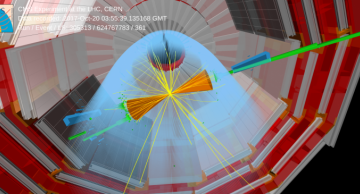The CMS collaboration has released the first observation of the simultaneous production of three W or Z bosons in proton-proton collisions at the Large Hadron Collider (LHC). The result is based on the data collected by CMS during 2016–2018 at a…
News
|
fblekman |
Physics
The eighth annual conference on Large Hadron Collider Physics (LHCP2020) is one of the important conferences for physics at the LHC. Originally planned to take place in Paris, LHCP is operating as a fully virtual conference this year. The CMS…
|
fblekman |
Physics
Have you ever pondered what happened to our Universe after the Big Bang? When the Universe was created, each particle was produced together with its antiparticle. For example, for each electron we see now, there was a positron created. But, some 13…
|
fblekman |
Physics
In Frozen, Anna and Elsa discover magical powers that open up a whole new world of possibilities. In Frozen 2, they go far Into the Unknown to understand the source of the magic that binds them all together. The CMS experiment is doing the…
|
fblekman |
Physics
The CMS Collaboration announced the first observation of a new way the B0s meson – a particle combining the beauty quark (b) and the strange quark (s) – can disintegrate. The observation involves two other particles, the well-known ϕ meson…
|
fblekman |
Physics
Identification of muons is essential for the physics done at the LHC. CMS has recently published a paper with new techniques to identify muons with high momentum. What is so special about muons with high momentum that they deserve a dedicated paper…
|
fblekman |
Physics
The CMS collaboration has achieved the first observation of a ttH process in a single Higgs boson decay channel. The Higgs boson is examined in its decay to two photons when produced alongside a top quark and antiquark. This enables the…
|
fblekman |
Physics
The CMS collaboration has examined for the first time the kinematic dependence of the production of a top quark and a W boson. This gives insight into the quantum interference of top quark production at the LHC and allows more accurate…
|
fblekman |
Physics
To investigate when the Standard Model will start breaking down, the CMS Experiment looks at extremely rare collisions where the Large Hadron Collider is working as a boson-boson collider. This can teach us more about the nature of the…
|
fblekman |
Physics
New, undiscovered charged particles could be produced by the LHC, leaving tracks in CMS that look similar to tracks from Standard Model particles. If the new particle decays to other, unseen new particles inside the CMS tracker, a very striking…
|
fblekman |
Physics
Nowadays, artificial neural networks have an impact on many areas of our day-to-day lives. They are used for a wide variety of complex tasks, such as driving cars, performing speech recognition (for example, Siri, Cortana, Alexa), suggesting…
|
fblekman |
Physics
At the LHC, protons do not collide one at a time. Instead, the protons are combined into bunches, packages of more than 100,000 million (1011) protons. These bunches are then pointed at each other at the four collision points of the LHC. Even when…












